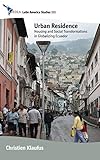Urban Residence : Housing and Social Transformations in Globalizing Ecuador / Christien Klaufus.
Material type: TextSeries: CEDLA Latin America Studies ; 100Publisher: New York ; Oxford : Berghahn Books, [2012]Copyright date: ©2012Description: 1 online resource (330 p.)Content type:
TextSeries: CEDLA Latin America Studies ; 100Publisher: New York ; Oxford : Berghahn Books, [2012]Copyright date: ©2012Description: 1 online resource (330 p.)Content type: - 9780857453716
- 9780857453723
- City planning -- Citizen participation
- City planning -- Ecuador -- Citizen participation
- Dwellings -- Ecuador -- Design and construction -- Citizen participation
- Housing development -- Ecuador -- Citizen participation
- Urban anthropology -- Ecuador
- SOCIAL SCIENCE / Sociology / Urban
- Urban Studies, Applied Anthropology, Sociology
- 307.1/21609866 23
- HT169.E24 K5313 2012
- online - DeGruyter
| Item type | Current library | Call number | URL | Status | Notes | Barcode | |
|---|---|---|---|---|---|---|---|
 eBook
eBook
|
Biblioteca "Angelicum" Pont. Univ. S.Tommaso d'Aquino Nuvola online | online - DeGruyter (Browse shelf(Opens below)) | Online access | Not for loan (Accesso limitato) | Accesso per gli utenti autorizzati / Access for authorized users | (dgr)9780857453723 |
Frontmatter -- Contents -- List of Figures and Tables -- List of Abbreviations -- Preface -- Introduction: Urban Living and Architecture -- 1. Intermediate Andean Cities -- 2. Neighborhood Dialectics -- 3. Habits in House Building -- 4. Fashionable Homes -- 5. Transformations in Cuencan Architecture -- 6. Riobamba, Disordered City -- 7. The Ordinary City -- Appendix: Ethnographic Urban Research -- Glossary -- References -- Index
restricted access online access with authorization star
http://purl.org/coar/access_right/c_16ec
Riobamba and Cuenca, two intermediate cities in Ecuador, have become part of global networks through transnational migration, incoming remittances, tourism, and global economic connections. Their landscape is changing in several significant ways, a reflection of the social and urban transformations occurring in contemporary Ecuadorian society. Exploring the discourses and actions of two contrasting population groups, rarely studied in tandem, within these cities—popular-settlement residents and professionals in the planning and construction sector—this study analyzes how each is involved in house designs and neighborhood consolidation. Ideas, ambitions, and power relations come into play at every stage of the production and use of urban space, and as a result individual decisions about both house designs and the urban layout influence the development of the urban fabric. Knowledge about intermediate cities is crucial in order to understand current trends in the predominantly urban societies of Latin America, and this study is an example of needed interdisciplinary scholarship that contributes to the fields of urban studies, urban anthropology, sociology, and architecture.
Mode of access: Internet via World Wide Web.
In English.
Description based on online resource; title from PDF title page (publisher's Web site, viewed 25. Jun 2024)


